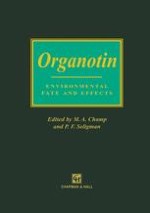1996 | OriginalPaper | Chapter
A Review of Acute Effects of Tributyltin Compounds on Aquatic Biota
Authors : Lenwood W. Hall Jr, Steven J. Bushong
Published in: Organotin
Publisher: Springer Netherlands
Included in: Professional Book Archive
Activate our intelligent search to find suitable subject content or patents.
Select sections of text to find matching patents with Artificial Intelligence. powered by
Select sections of text to find additional relevant content using AI-assisted search. powered by
The objective of this chapter was to collect, synthesize, and interpret data on acute tributyltin (TBT) toxicity for both freshwater and saltwater organisms. Survival of test organisms (LC50) was the most frequently used endpoint for these experiments, although other sublethal parameters were also evaluated. Tributyltin toxicity data were evaluated for 29 freshwater species and 56 saltwater species. Most of the freshwater data and approximately half of the saltwater data were generated from experiments using nominal concentrations of TBT. Acute toxicity data generated from studies using nominal concentrations are suspect because TBT is hydrophobic and tends to adsorb to most contact material. Tributyltin also degrades in solution over time. The most sensitive freshwater species tested was the coelenterate Hydra sp. [96-h LC50 = 0.5 µg l-1 tributyltin oxide (TBTO)]. The bluegill (Lepomis macrochirus) was the most resistant freshwater species with a 96-h LC50 of 240 µg l-1 TBTO. Copepods and mysids were the most sensitive saltwater organisms with acute effects reported at TBT concentrations of 0.4–0.5 µg l-1. Adult oysters were reported to be the most resistant saltwater species with 96-h LC50 values >200 µg l-1 TBT.
